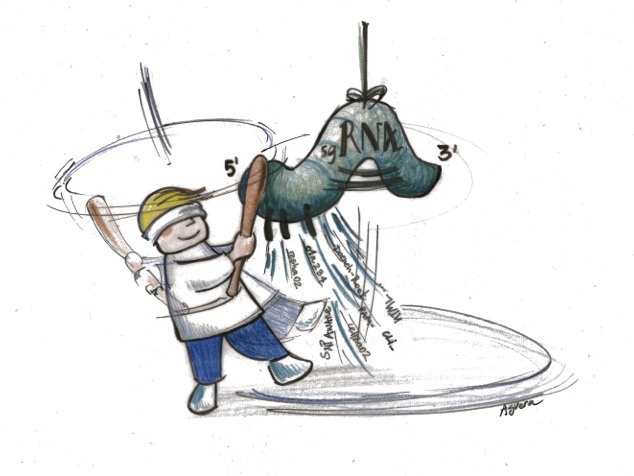
Image taken from Addgene’s blogpost on CRISPR software tools
CRISPR is taking the world by storm. The latest gene editing technique surpasses current known methods due to its ease of application, low cost, and ability to be used in almost any system. The only concern that many have however is the extent of its off-target effects. Several studies have been performed trying to characterize this, and the mass consensus is that the off-target effects vary with the guide RNA (gRNA) used. In one study, the number of off-target effects for each single gRNA ranged from 0-150! gRNAs can also tolerate bulges in DNA and not just single-base mismatches, increasing their propensity for non-specific binding. And unfortunately, current computational tools cannot readily predict off-target events based on gRNA sequences.
The Cas9 enzyme bears some influence on off-target activity as well. A recent study found that the extent of off-target effects could be reduced by using a modified Cas9 with lower binding energies towards DNA. This supposedly prevents non-specific associations with non-target DNA sites.
So yes off-targets are a matter of concern when doing CRISPR experiments, which means there’s still a lot to be done before this gene editing technique sees the light of clinical trials. But for the sake of the ordinary scientist, here’s a list of ways you could reduce off-targets in your own CRISPR experiment (hopefully using cells/animals):
1. Use the Cas9 recombinant protein rather than a plasmid. Studies have found this reduces off-target effects, presumably because expression of Cas9 is more transient. Having Cas9 in a plasmid induces expression of Cas9 that tends to accumulate over days and may lead to more non-specific Cas9-mediated cleavages.
2. Use gRNAs that begin with GG at the 5′ end. Reasons are unknown but these gRNAs tend to be more specific.
3. Use shorter gRNAs. Specifically, 17 to 18 nucleotide long gRNAs were found to be more specific than their 20 nucleotide long counterparts. This might again be due to their lower binding energy, however the shorter sequences limit the ability to choose specific sequences. So it is useful to note that mismatch tolerance on the gRNA is position dependent as well, with base 8-14 at the 3′ end of the gRNA being less tolerant to mismatches compared to the 5′ end. Also, stick to 40-60% GC content.
4. Use D10A Cas9 nickase. This is a modified version of Cas9 that nicks (i.e cuts only one strand of the DNA) rather than cuts. So one would have to design two gRNAs that target both strands of DNA at the specific site in order for Cas9 D10A nickase to produce a complete double-strand break. And as you can imagine chances of this happening non-specifically are really low. In the same vein, a dead mutant Cas9 (dCas9) fused to FokI has also been designed where two dCas9-FokI molecules are required to bind both strands on the target site before FokI-mediated cleavage can occur.
5. Use a different Cas9 ortholog with longer PAM requirements. The longer PAM sequences enforce an additional sequence requirement for cleavage and Cas9 orthologs from Staphylococcus aureus, Streptococcus thermophilus and Neisseria meningitidis have all been found to have reduced off-target activity.
6. Target the promoter/transcription start site region. These regions tend to have a more open chromatin structure that allows better gRNA-Cas9 access. Further studies found that seed sequences that are more likely to form secondary structures, tended to have a greater chance of being cut by gRNA-Cas9.
7. Don’t use too much DNA during transfection. This kind of correlates with RNAi experiments where higher siRNA concentrations lead to more off-target effects. Large amounts of transfection reagent/DNA could trigger an immune/toxic response within cells that result in random DNA strand breakages.
So you’ve followed all the above rules, now comes the question, just how do you make sure there really have been no off-target events?
There have been many genome-scale monitoring methods devised. Many tried to detect Cas9 binding sites (via ChIP-Seq or SELEX) but then realized that Cas9 binding does not necessarily correlate with Cas9 cleavage. Some performed Cas9 cleavages in vitro followed by sequencing to characterize cleavage sites (Digenome-Seq) but could only detect a small subset of actual off-target events, indicating an in vivo context may be required. The GUIDE-seq approach detected sites of incorporation of a short double-stranded DNA fragment into gRNA-Cas9-mediated cuts that can occur during non-homologous end joining (NHEJ), and identified more off-target sites than any other method. However these read-outs are also likely underestimations of actual off-target frequencies since cleavage events may occur without fragment incorporation.
To perform a more targeted approach, one could come up with a list of possible off-target sites based on 1-3 tolerated mismatches near the 5′ end. And target your sequencing or endonuclease assays towards those regions. You might be restricting yourself but at least it provides some assurance that your gRNA is showing some respectable specificity. I hope I have covered enough ground, but if you would like to read more, try here, here and here. And for a refresher on how CRISPR works, you can read this old blog post.
